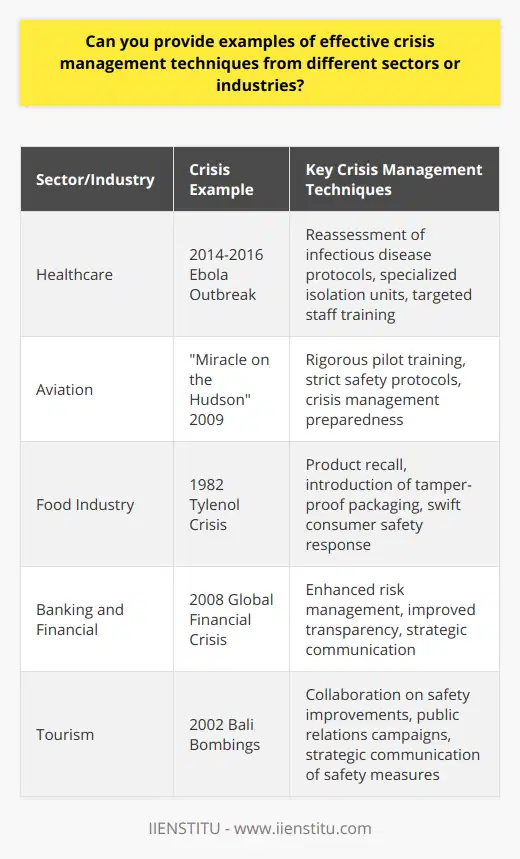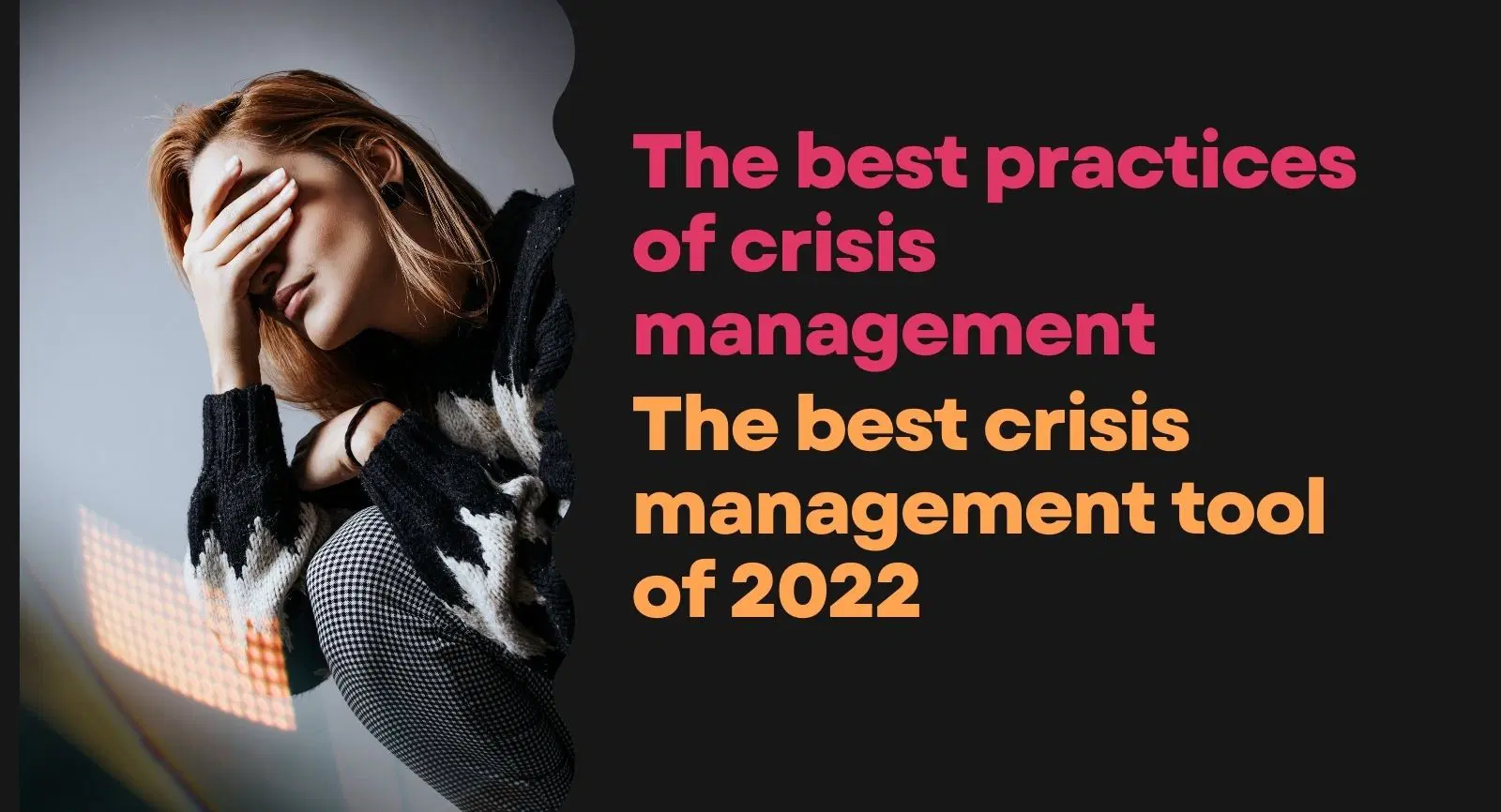
Businesses and organizations of all sizes can be affected by crises. Either they affect the company directly, such as a natural disaster or product recall, or they emerge from environmental and social issues that affect society more broadly, like protests over an oil pipeline in North America.
A crisis is a set of conditions that pressure managers to address unanticipated questions and events that could negatively impact their operations. These include financial losses, compromised procedures, damaged equipment, lost talent pressure, and reputational damage. Crisis management planning helps an organization anticipate these challenges and develop processes for addressing them effectively.
Summary
Learn from the ways other companies have dealt with crises
Increase your company's reputation post-crisis
Save money and time if a crisis ever should occur
Unfortunately, many companies do not consider this until after the fact — when they launch a review to understand how they handled a specific incident — or worse: They do not develop a crisis management plan.
A crisis is an incident that has the potential to endanger your project. This includes environmental and social happenings, such as natural disasters or political protests; supply chain disruptions; loss of key talent; reputational damage (e.g., client complaints); terrorist attacks; outbreaks of diseases or viruses; product recalls; fatalities or severe injury onsite due to equipment failure; chemical spills affecting nearby communities; construction accidents involving third party contractors; disruptions in utilities (water, power, telecommunications) and transportation networks; financial crises that affect critical resources (e.g., capital markets shutting down); or cyberattacks that shut down systems or release sensitive information.
Crises generally have three phases: activation, management, and recovery.
Activation starts with getting up to speed on what is happening, confirming how it affects your operation, and mobilizing resources to address impacts.
Management involves tracking developments, initiating communications with stakeholders, including employees, customers, investors, and suppliers; assessing capacity for containment or mitigation; preparing sites or businesses for adverse conditions (e.g., opening an evacuation center); securing equipment or sensitive information; arranging support from local authorities (e.g., police protection during a demonstration) or external sources (e.g., insurance policies covering damage from rioting mobs). It may also entail stepping up security measures at critical sites where relevant facilities are concentrated, such as laboratories containing infectious organisms in biotechnology companies or oil wells located in politically unstable areas.
Recovery starts when the crisis is controlled and ends when the business or organization has returned to normal operations.
A guide to crisis management
The goal of crisis management is to minimize the negative impacts of an incident on your project so that you can resume normal operations as quickly as possible. This involves three key activities:
Containment: Preventing a situation from worsening by taking appropriate steps to protect people, property, and the environment.
Mitigation: Reducing the consequences of an incident by limiting damage, repairing any damage that has occurred, and implementing measures to prevent future incidents.
Restoration: Returning the impacted area to its pre-crisis state as closely as possible.
For an organization to effectively manage a crisis, it is essential to have a crisis management plan. This document should outline the oorganization'sresponse procedures for different problems, as well as the roles and responsibilities of key personnel. The crisis management team should also practice responding to simulated concerns and be prepared to act quickly and effectively when an incident occurs.
There are many things that businesses can do to prepare for a crisis, including:
1. Identifying potential threats or vulnerabilities that may have emerged.
2. Developing a crisis management plan. The crisis management plan should outline the oorganization'sresponse procedures for different types of crises, as well as the roles and responsibilities of key personnel. The crisis management team should also practice responding to simulated concerns and be prepared to act quickly and effectively when an incident occurs.
3. Training employees on responding to a crisis and empowering them to take appropriate steps when a situation arises.
4. Being aware of local, national, and global events that may affect the organization or its stakeholders (e.g., political unrest or natural disasters) and planning how these events could impact your business operations.
5. Ensuring that IT systems can be shut down orderly in a crisis so that sensitive data is not compromised. It may also be necessary to move equipment into secure locations where it will not be accessible by unauthorized personnel during a crisis.
6. Implementing effective security measures for protecting company property, including storing sensitive documents away from office areas where they are less likely to be accessed during a disruption event (e.g., locked in a drawer at the home office).
7. Ensuring that physical and IT security measures are in place so that sensitive company data and equipment cannot be accessed by unauthorized personnel during a crisis (e.g., locking server cabinets or filing cabinets if they contain essential documents).
8. Keeping hard hats, safety glasses, and other necessary tools on hand to ensure personnel can safely carry out their duties during an incident (e.g., repairing damaged property).
9. Develop procedures for how people will communicate with one another about an incident, including details about how different types of stakeholders will be contacted (e.g., employees, clients, executives, or suppliers) and which communication channels will be used to reach them (e.g., email, text message, social media).
10. Preparing an emergency communications plan that will be activated if the osevereorganization'snormal communication channels are unavailable (e.g., a power outage or telecommunications failure).
11. Securing physical evidence such as documents, computer hard drives, and other items that could be used in legal proceedings following a crisis. Protecting electronic data from unauthorized access or theft may also be necessary, such as by password-protecting files or encrypting sensitive information.
12. Planning for the safe evacuation of personnel in a crisis (e.g., fire, toxic fumes).
13. Developing procedures for shutting down IT systems, moving equipment to secure locations, and protecting sensitive data in a crisis (e.g., backup copies of files and offsite storage).
14. Arrange insurance coverage to protect your business against potential losses caused by a crisis (e.g., property damage or business interruption).
15. Review the crisis management plan regularly and update it as necessary to reflect changes in the organization or the environment.
Developing a comprehensive crisis management plan is an essential step for any business, but it is not a task that should be completed once and then forgotten. Instead, the project should be reviewed regularly and updated to remain relevant and practical. By taking these steps, businesses can reduce the risk of experiencing negative consequences following a crisis and ensure that they are prepared to deal with it quickly and effectively.
1. Identify potential crises.
2. Develop a crisis management plan. The plan should include the following:
3. Keep employees informed about the company's crisis management plan by providing regular training on how to respond in an emergency, empowering them to take appropriate action when necessary.
4. Take steps to protect sensitive data by backing up files regularly, encrypting certain types of information (e.g., trade secrets), and keeping backup copies off the premises if possible.
5. Establish procedures for shutting down IT systems in an orderly manner without causing damage or leaving equipment inaccessible during a disruption event (e.g., a power outage or fire).
6. Store essential documents in a safe place where they can be accessed easily in the event of a crisis (e.g., offsite storage). It may also be i
7. Ensure that physical and IT security measures are in place so that sensitive company data and equipment cannot be accessed by unauthorized personnel during a crisis (e.g., locking server cabinets or filing cabinets if they contain essential documents).
8. Keeping hard hats, safety glasses, and other necessary tools on hand to ensure personnel can safely carry out their duties during an incident (e.g., repairing damaged property).
9. Develop procedures for how people will communicate with one another about an incident, including details about how different
The examples of crisis management given above are just a few of the many steps businesses can take to protect themselves from potential negative consequences. By being proactive and putting a comprehensive crisis management plan in place, companies can reduce the risk of experiencing significant damage following a crisis. However, it is essential to remember that no goal is perfect, and incidents can still happen. Therefore, it is also necessary to have a response plan ready to implement in an emergency. This should include clear instructions for how employees should respond and what actions need to be taken to mitigate the damage caused by the crisis. By accepting these precautions, businesses can minimize the negative impact a problem can have on their operations.
Questions
What are some examples of crisis management in the public industry?
How do you maintain transparency when you're in the middle of a crisis?
Have you ever handled a PR event in which one of your employees made controversial remarks online or offline, and how did it impact the company's reputation?
Why is crisis management important to businesses nowadays?
How can you handle media inquiries after something terrible has happened to your business (e.g., hack, job termination)?

Frequently Asked Questions
What are the components of a comprehensive crisis management plan?
A comprehensive crisis management plan should include steps to identify potential crises, develop a crisis response plan, keep employees informed and trained, protect sensitive data and IT systems, store important documents securely, establish procedures for dealing with disruptions, and ensure physical. In addition, IT security measures are in place, and maintain safety equipment.
Additionally, businesses should also have procedures in place for how to communicate with one another during a crisis and how to handle media inquiries. Finally, it is essential to review the plan regularly and ensure that everyone involved understands their roles and responsibilities in an emergency.

How often should the crisis management plan be reviewed?
It is essential to review the crisis management plan regularly and update it as needed to remain relevant. This ensures that the business is prepared to quickly and effectively deal with potential emergencies. The program should be reviewed annually or after significant business operations changes. It is also essential to review the project between these checks, for example, if any new threats have arisen since the last review. This will ensure that the plan remains up-to-date and effective.
Additionally, any new staff should be trained on the plan. This will help ensure that everyone is aware of what needs to be done in a crisis. Finally, it is essential to carry out regular drills and simulations to ensure that the plan works as intended and that employees understand their roles in an emergency.
What should businesses do in order to minimize the impact of a crisis?
Businesses must take proactive steps by developing a comprehensive crisis management plan before an emergency arises. Additionally, they need a ready response plan that includes clear instructions on how personnel should respond to mitigate damage caused by an incident. In addition, they may also want to consider having media relations training for employees who may have contact with journalists or other industry representatives during times of distress. Other lessons from previous experiences can also help prepare businesses for future scenarios. Taking these precautions can help to minimize the negative impact of a crisis.
Finally, businesses must remember that a crisis can often be an opportunity for growth and development. In the aftermath of a problem, taking stock of what went wrong and celebrating successes can help businesses improve and strengthen their future strategies. This can ultimately lead to better outcomes in the long term.
Ultimately, taking the proper steps to develop a crisis management plan can help businesses protect their reputation and reduce the risk of financial losses. In addition, by being proactive and prepared, companies can be better equipped to handle any crisis.
What is the role of communication in effective crisis management?
Role of Communication in Crisis Management
Effective Communication Strategies
The role of communication in effective crisis management is vital as it determines the success or failure of the organization's response to a crisis situation. To ensure a successful outcome, leaders must deploy effective communication strategies that include sharing accurate, timely, and relevant information with relevant stakeholders, such as employees, customers, and the public.
Building Trust and Confidence
Fostering a sense of trust and confidence among stakeholders is crucial during a crisis. Transparent and honest communication is essential in building and maintaining stakeholders' trust, reducing uncertainty, and preventing the spread of misinformation. Consistent, open communication allows organizations to demonstrate concern for the well-being of their stakeholders, ensuring credibility and boosting their reputation in the long run.
Coordination and Collaboration
Efficient communication facilitates the essential coordination and collaboration between different departments, teams, and individuals involved in crisis management. Information exchange reduces ambiguities, minimizes duplication of efforts, and ensures all parties work towards shared goals. Effective communication also aids in avoiding confusion and misunderstanding by establishing a clear chain of command and delineating roles and responsibilities.
Early Detection and Response
Timely communication plays a crucial role in the early detection of potential crises. By encouraging open communication within the organization, employees can report potential threats or issues, enabling the organization to take preventive measures and mitigate risks. Prompt communication during the crisis then helps organizations react quickly and adapt their strategies to the evolving situation.
Support and Reassurance
During a crisis, communication should provide support and reassurance to affected parties. Empathic communication, which addresses fears and concerns, helps alleviate anxiety and regain trust. Moreover, conveying a clear plan to address the crisis and providing regular updates on progress can assure stakeholders that the organization is taking decisive actions to manage and overcome the adverse situation.
In conclusion, effective communication is imperative for successful crisis management. By ensuring transparent, timely, and accurate information, organizations can build trust, foster coordination and collaboration, facilitate early detection and response, and provide support and reassurance to effectively navigate through challenging circumstances.
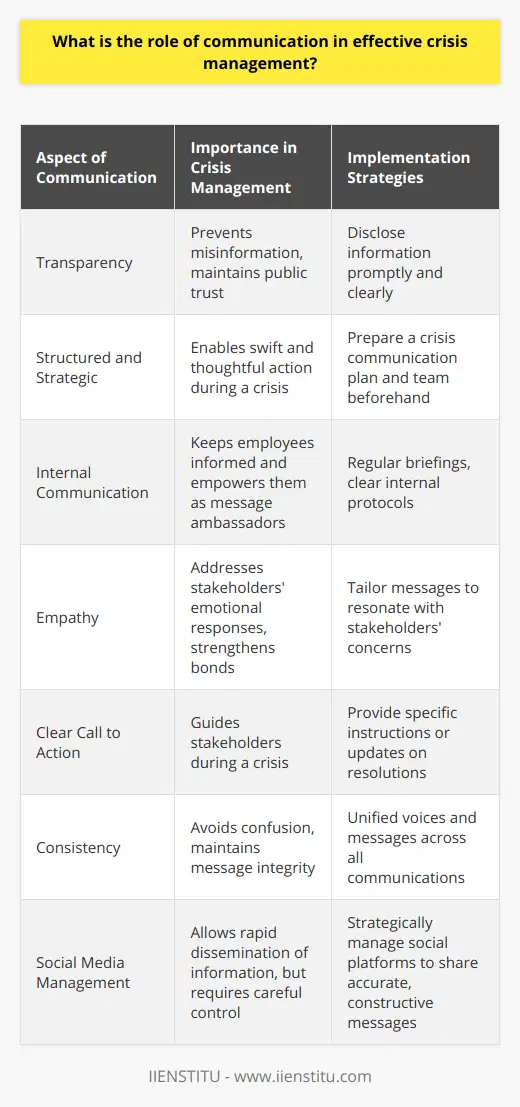
How can organizations build resilience to better handle potential crises?
**Understanding Crises**
To build resilience against potential crises, organizations must first have a thorough understanding of the types of crises they may face. This involves identifying internal and external risks and conducting regular assessments to determine the likelihood of such events. With a clear understanding of the potential threats, organizations can prioritize their efforts to mitigate these risks and prevent crises from occurring.
**Developing a Robust Plan**
A resilient organization develops robust plans to deal with different types of crises ranging from personnel issues to system failures. These plans should include predefined actions, escalation mechanisms, communication protocols, and necessary resources to handle unexpected events effectively. Regular review and updating of these plans are essential to ensure they remain effective and relevant as the organization grows and changes.
**Implementing Preventative Measures**
Preventative measures are an essential aspect of building resilience against potential crises. By implementing controls and safeguards, organizations can reduce the chances of crises occurring or minimize their impact if they do occur. Examples of preventative measures include regular employee training, robust cybersecurity, and strong operational processes.
**Establishing a Crisis Management Team**
A dedicated crisis management team with clearly defined roles and procedures can significantly enhance an organization's ability to respond effectively to a crisis. This team should be made up of key personnel from various departments, including management, communications, and technical support. Their primary responsibilities should include quickly assessing a crisis, coordinating the response, and managing communication with key stakeholders.
**Continuous Learning and Improvement**
Organizations need to adopt a culture of continuous learning and improvement to build long-term resilience against potential crises. This involves regularly reviewing the effectiveness of their existing crisis management strategies and making relevant changes based on lessons learned. Additionally, organizations should encourage employees to report concerns or potential risks and hold regular discussions to identify possible areas for improvement.
**Conclusion**
In conclusion, building resilience against potential crises involves a multifaceted approach, which includes understanding potential risks, robust planning, preventative measures, a dedicated crisis management team, and continuous learning and improvement. By adopting these strategies, organizations can not only better handle crises but also thrive amid uncertainty and change.
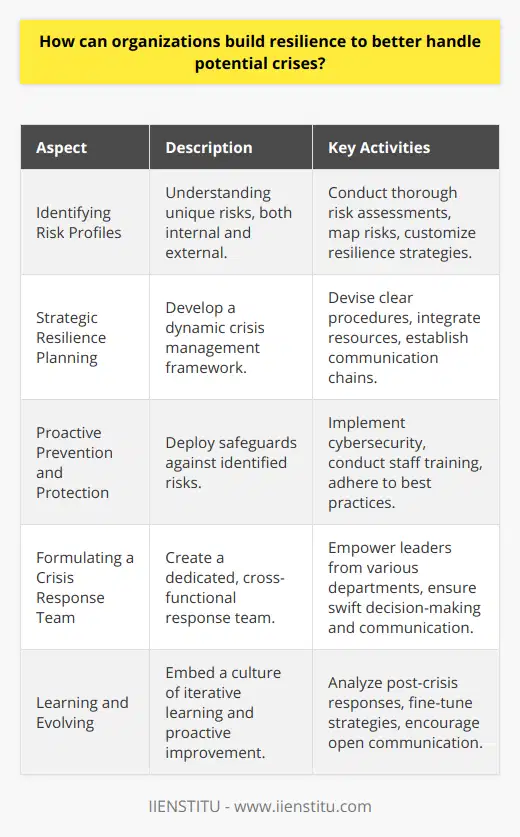
What are the key elements for successful leadership during a crisis situation?
Effective Communication
A key element for successful leadership during a crisis situation is effective communication. Leaders must convey clear, concise, and timely information to their team and stakeholders, ensuring everyone is aware of the situation's severity and the required actions.
Decisive Action
Leaders must demonstrate the ability to make tough decisions quickly, even with limited information. It is crucial for leaders to act promptly and decisively in crisis situations, as hesitation or procrastination may exacerbate the problem or lead to missed opportunities.
Adaptability and Flexibility
In crisis situations, successful leaders must display adaptability and flexibility. They need to be open and willing to change previously established plans and strategies if new information or challenges arise, allowing them to navigate uncertain and rapidly changing environments.
Empathy and Support
An empathetic leader is an essential factor for success during a crisis. A leader who can understand and acknowledge the feelings and concerns of their team members, providing necessary support, will be able to maintain morale in challenging circumstances.
Team Collaboration
Promoting and fostering a collaborative environment within a team can contribute to the success of a leader during a crisis. Encouraging input from all team members allows for diverse perspectives and ideas, which can lead to creative and effective solutions for complex problems.
Risk Management
Leaders in crisis situations must prioritize risk management. By identifying and assessing potential risks and implementing effective prevention and mitigation strategies, a leader can minimize the impact of the crisis and ensure a swift recovery.
Accountability and Responsibility
Finally, a successful leader during a crisis must take ownership of their decisions and actions. Demonstrating accountability and responsibility in both successes and failures fosters trust and transparency, which are vital for maintaining a positive team dynamic and moving through the crisis effectively.
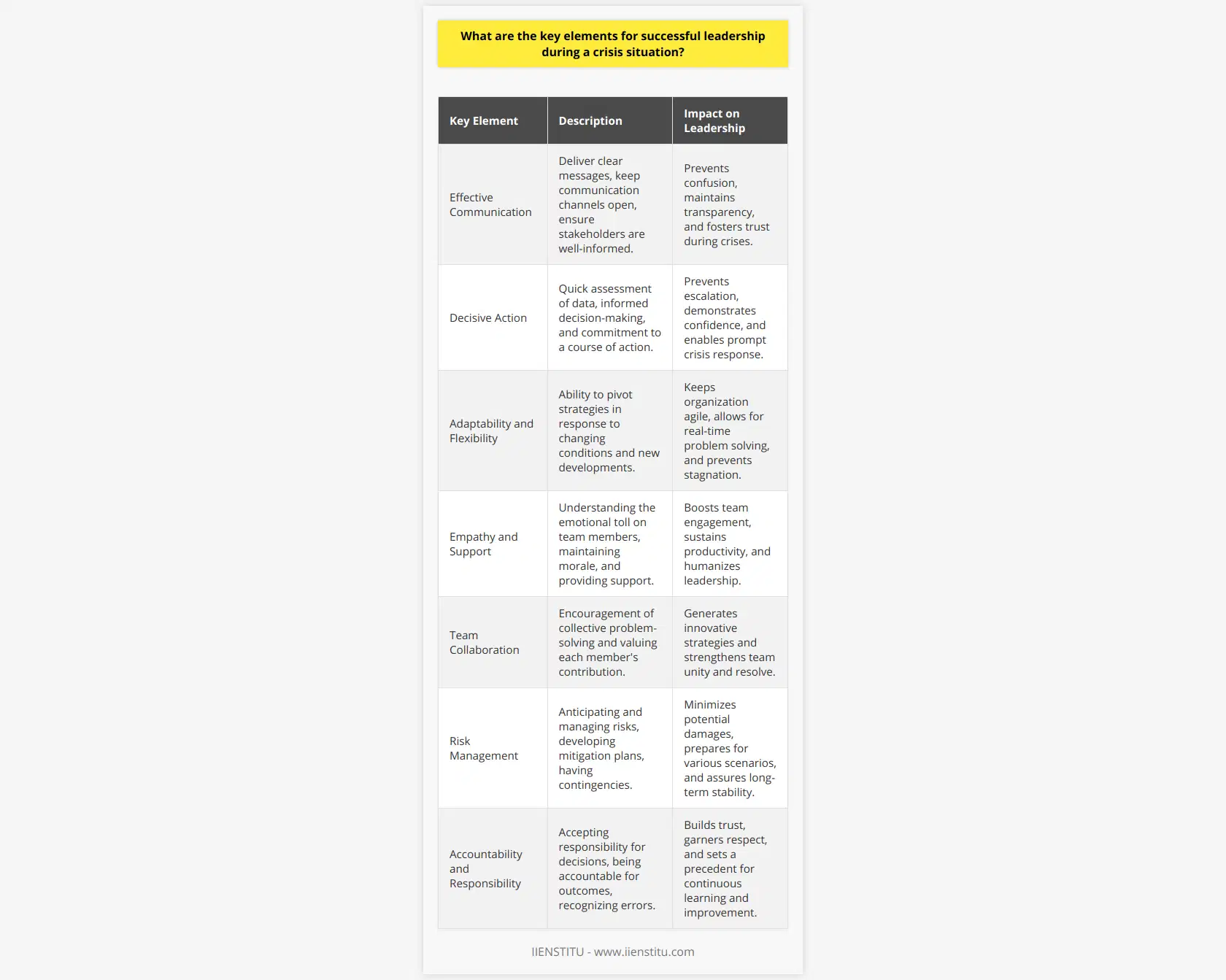
What are the 3 types of crisis management?
Types of Crisis Management
Crisis management is a critical aspect of ensuring organizational stability and resilience in the face of unexpected situations that pose significant threats to its operations or reputation. There are three main types of crisis management strategies: proactive, reactive, and adaptive crisis management. These approaches can be employed individually or in combination to effectively manage various crises.
Proactive Crisis Management
Proactive crisis management focuses on anticipating potential crises by closely monitoring internal and external factors that may lead to problematic situations. This strategy involves conducting risk assessments, developing contingency plans, and providing employee training to mitigate the impact of potential crises. By anticipating potential threats, proactive crisis management enables organizations to take preventative measures and reduce the likelihood of crises occurring in the first place.
Reactive Crisis Management
Reactive crisis management is employed when a crisis has already occurred, and immediate actions must be taken to minimize its negative effects on an organization. This approach requires effective communication, rapid decision-making, and efficient allocation of resources to address the situation. Reactive crisis management involves quickly identifying the cause of the crisis, evaluating the organization's response options, and implementing the most appropriate solutions to restore stability and prevent further damage.
Adaptive Crisis Management
Adaptive crisis management is an approach that allows organizations to continuously evaluate their crisis management strategies and modify them as needed based on new information, changes in the environment, or shifts in organizational goals. This type of crisis management prioritizes learning and improvement as a means of increasing organizational resilience and reducing vulnerability to future crises. Implementing adaptive crisis management involves regularly reviewing crisis response plans, incorporating feedback from previous crisis experiences, and adjusting strategies accordingly.
In conclusion, proactive, reactive, and adaptive crisis management strategies are essential for organizations looking to maintain stability and resilience in the face of potential threats. By employing these approaches, organizations can better anticipate, respond to, and learn from crises, ultimately reducing their vulnerability and ensuring continued success.
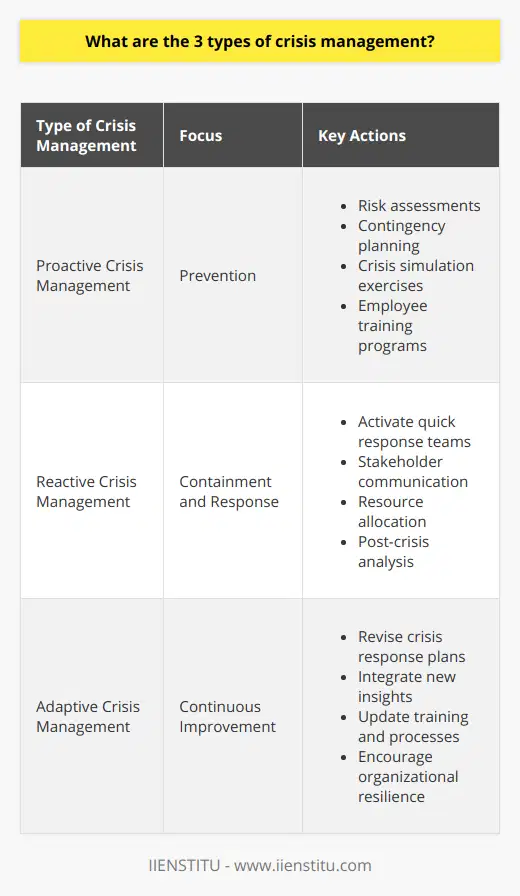
What are 5 examples of crisis?
Natural Disasters
One form of crisis stems from natural disasters, such as earthquakes, tsunamis, hurricanes, and wildfires, which devastate communities and cause significant damage to infrastructure and economies, requiring extensive recovery efforts.
Economic Crises
Financial crises, such as the 2008 Global Financial Crisis, or localized recessions, constitute another type of crisis that can lead to massive unemployment, a decrease in consumer spending, and overall economic distress, impacting communities and nations alike.
Public Health Emergencies
Widespread public health crises, like the COVID-19 pandemic, pose significant challenges to the well-being of populations, overwhelming healthcare systems, and often resulting in government-imposed restrictions that have considerable social and economic consequences.
Political Turmoil
Political instability, including civil wars and government coups, creates crises that often endanger the safety and security of civilian populations, disrupt the functioning of societies, and exacerbate existing social and economic issues.
Humanitarian Crises
Lastly, humanitarian crises, such as the Syrian refugee crisis or the ongoing Yemen conflict, encompass a range of distressing events that displace large numbers of people, seek international attention and aid, and require long-term solutions to address dire living conditions and human suffering.
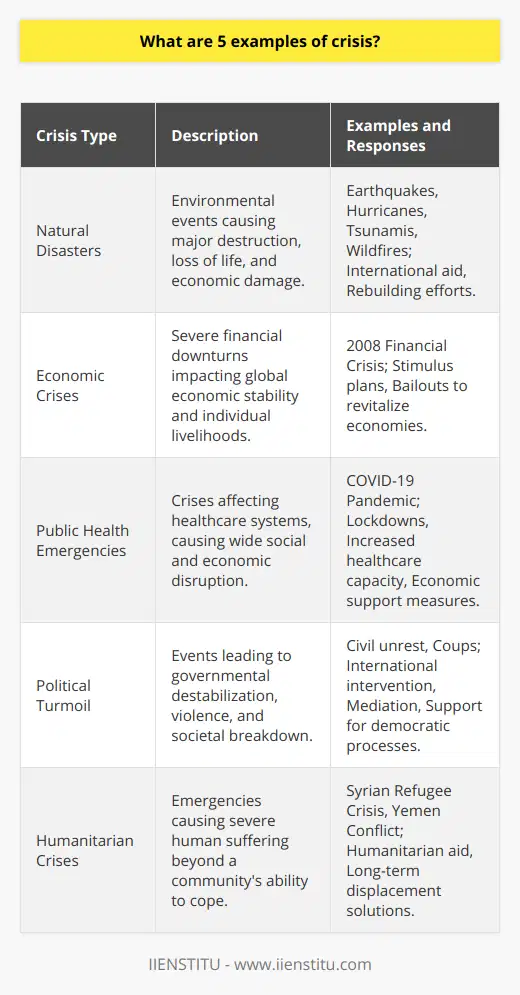
What is an example of crisis intervention in real life?
Role of Crisis Intervention
Crisis intervention refers to immediate assistance provided during an individual's or a community's difficult situation with the aim to minimize the potential negative impact of the crisis. It mainly focuses on short-term support and aims at stabilization of the individual or community. A real-life example of crisis intervention during a crisis can be observed in the response to natural disasters or traumatic incidents, such as Hurricane Katrina in 2005 or the mass shootings in the United States.
Natural Disaster: Hurricane Katrina
Hurricane Katrina was one of the deadliest and costliest hurricanes in the history of the United States. It caused widespread devastation in New Orleans and various other coastal areas of Louisiana, Mississippi, and Alabama. Consequently, affected individuals experienced various forms of crises such as physical injury, loss of loved ones, and undesirable displacement.
Crisis Intervention Teams (CITs)
Shortly after the hurricane, numerous crisis intervention teams were deployed to affected areas. These teams included professional counsellors, social workers, and mental health practitioners. Their primary goal was to identify and address the immediate needs of the affected population.
Psychological First Aid (PFA)
One of the essential tools used by the CITs in this situation was Psychological First Aid (PFA). PFA is an evidence-based intervention approach that emphasizes the importance of safety, calming techniques, connectedness, and self-efficacy in the immediate aftermath of a crisis. It is designed to reduce stress and foster adaptive functioning among affected individuals.
Provision of Basic Needs
In addition to the above-mentioned psychological support, the crisis intervention teams also strived to provide basic necessities such as food, water, and shelter to affected individuals. The provision of these basic needs significantly contributed to alleviating immediate stressors and enhancing the well-being of those affected by Hurricane Katrina.
Long-term Recovery Programs
Following the early phase of the crisis intervention, longer-term recovery programs were established to assist individuals and communities in restoring their lives. This could include referrals to different service providers, such as medical and mental health professionals or financial assistance programs, to ensure a comprehensive and sustainable recovery process.
Conclusion
Crisis intervention plays a crucial role in addressing the immediate physical, psychological, and emotional needs of affected individuals during unexpected crises. Implementing appropriate intervention strategies can improve overall well-being, promote resilience, and help individuals and communities recover from the devastating effects of crises like Hurricane Katrina.

What is an example of a crisis management cycle?
Crisis Identification and Assessment
A prominent example of a crisis management cycle is the widely adopted PDCA (Plan-Do-Check-Act) framework. This cyclical model emphasizes continuous improvement and is applicable to various organizational settings, including businesses, governments, and non-profits. The PDCA framework is structured around four distinct phases that guide organizations through the necessary steps to prevent and respond to crises.
Planning and Preparation
First, the planning phase involves identifying potential crises and devising strategies to prevent or minimize their impact. This includes assessing the organization's vulnerabilities, analyzing potential threats, and developing contingency plans. Creating a crisis communication plan and assembling a crisis management team are essential aspects of this phase. Effective planning enables organizations to increase their resilience and improve their ability to navigate unforeseen events.
Implementation and Response
Within the implementation phase, the organization executes the planned strategies once a crisis occurs. Swift and decisive action is crucial in mitigating the immediate effects of the crisis while maintaining the organization's reputation and stakeholder trust. This step involves implementing emergency response procedures, disseminating information to relevant stakeholders, and cooperating with external entities such as law enforcement agencies or regulatory authorities.
Evaluation and Recovery
The check phase of the PDCA cycle requires organizations to evaluate their crisis response efficacy, identifying strengths and weaknesses in their existing plans. This evaluation is essential for learning from past experiences and refining strategies to better manage future crises. Moreover, the recovery process involves restoring normal operations and implementing necessary changes to prevent recurrence of the crisis or mitigate its future impact.
Continuous Improvement and Adaptation
Finally, the act phase reinforces the cyclical nature of the crisis management cycle by emphasizing that organizations must continuously adapt and improve in response to the changing environment. This entails refining strategies, updating crisis plans, and maintaining agility in managing unforeseen events. By fostering a culture of continuous improvement, organizations can better prepare for and navigate crises, contributing to long-term success and resilience.
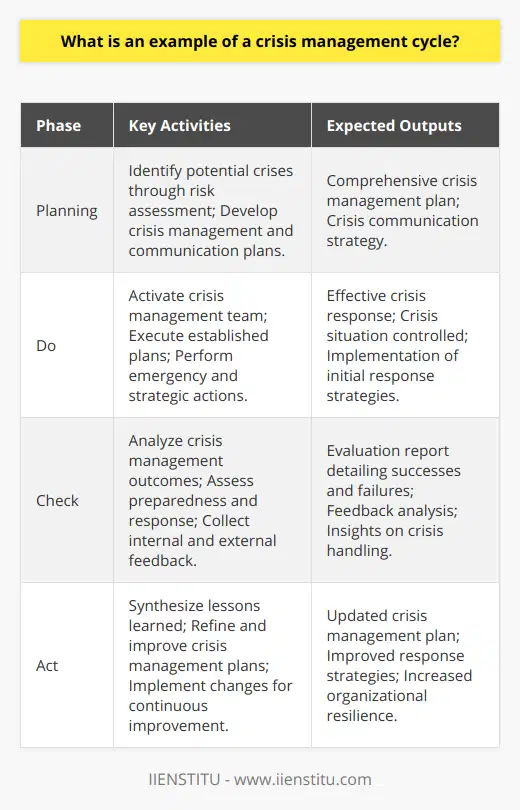
How do different organizations approach crisis management differently?
Organizational Crisis Management Approaches
Crisis management refers to the strategies and procedures an organization adopts to navigate unexpected challenges and minimize negative outcomes. Various organizations embrace different methodologies for crisis management, depending on factors such as resources, size, and industry.
Proactive vs. Reactive Strategies
Proactive strategies involve anticipating potential crises and preparing in advance with a well-defined plan. In contrast, reactive strategies focus on addressing crises in real-time and implementing solutions as the situation unfolds. Organizations often use a mix of both approaches, emphasizing one over the other depending on the organization's nature.
Risk Assessment and Prioritization
Organizations might approach crisis management through risk assessment and prioritization. This method entails identifying potential threats and categorizing them based on the probability of occurrence and potential impact. Having a clear understanding of these risks empowers organizations to allocate resources and develop appropriate countermeasures.
Internal vs. External Communication
Another factor influencing organizational approaches to crisis management is the focus on internal or external communication. Some organizations prioritize establishing a clear and transparent information flow among employees and stakeholders. In contrast, others might emphasize public relations and shaping public perception through media engagement and press statements.
Role of Leadership
Leadership plays a crucial role in an organization's approach to crisis management. A strong, decisive leader can inspire confidence, maintain morale, and contribute to a faster recovery. On the other hand, a weak or indecisive leader might aggravate the crisis by failing to take timely and effective decisions.
Crisis Management Teams and Collaboration
Organizations might establish dedicated crisis management teams to handle emergencies effectively. These teams, often comprised of employees from various departments, can coordinate their efforts for a unified response. Collaboration with external organizations, such as government agencies, industry groups, and third-party consultants, is also essential to strengthen crisis management strategies.
Continuous Learning and Adaptation
Finally, successful organizations recognize the need for continuous learning and adaptation in crisis management. This includes analyzing past incidents, learning from mistakes, and regularly updating crisis management plans and strategies. By adopting a proactive, risk-aware, and collaborative approach, organizations can better manage crises and minimize negative impacts on their operations and stakeholders.
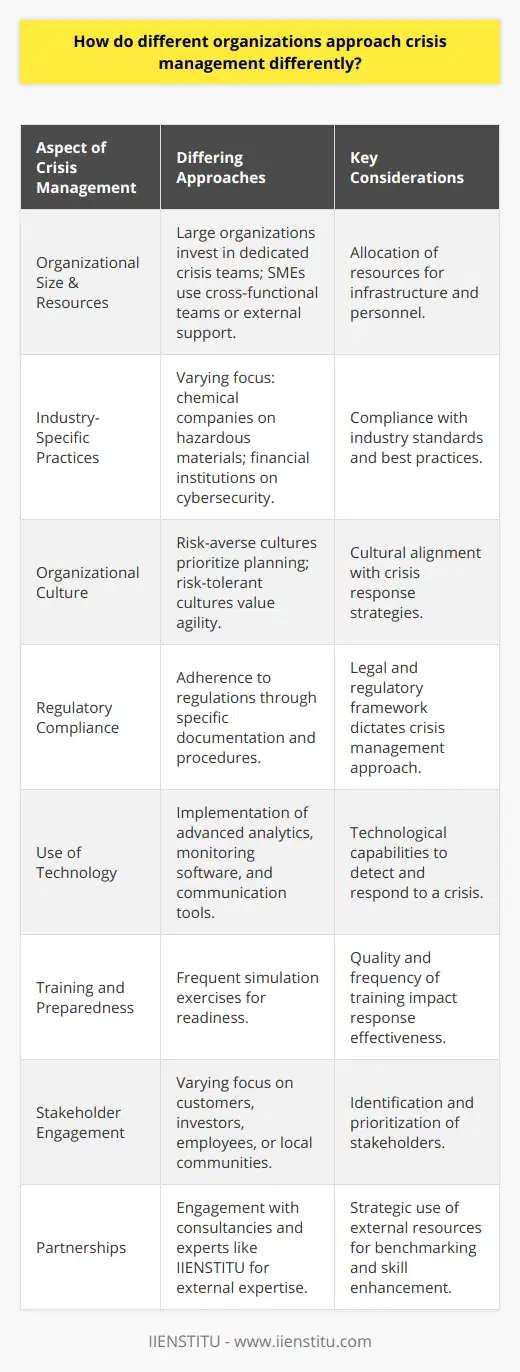
What factors influence the effectiveness of crisis management in public and private organizations?
Context and Preparedness
The effectiveness of crisis management in public and private organizations primarily depends on the context in which they operate and their level of preparedness. The context comprises the organization's size, geographic location, and the potential crises it may face. Well-prepared organizations have comprehensive plans, clearly defined roles, and proper resources allocation to cope with a crisis.
Coordination and Trained Staff
Moreover, coordination between different departments and trained staff plays a significant role in managing crises effectively. Timely communication, a trained response team, and a strong decision-making process directly impact the success of crisis management. Periodic training and simulation exercises also contribute to enhancing the crisis response capability of organizations.
Adaptive and Proactive Approach
An adaptive and proactive approach is another vital factor that influences the effectiveness of crisis management. Organizations with well-established early warning systems and monitoring processes can promptly detect and address potential crises. Adopting a forward-thinking strategy helps in minimizing the damages and achieving faster recovery post-crisis.
Organizational Culture
Organizational culture influences the crisis management effectiveness by affecting the way employees perceive and respond to crises. A culture that encourages open communication, learning from past experiences, and shared responsibility fosters better crisis handling. In addition, having a dedicated crisis management team and a solid contingency plan in place increases the chances of successful crisis management.
Stakeholder Involvement
Lastly, stakeholder involvement significantly affects the crisis management outcomes. Engaging internal and external stakeholders in risk assessments, decision-making, and communication helps organizations navigate through crisis situations effectively. Transparent information sharing and timely updates to stakeholders build trust and strengthen relationships, which in turn facilitates better crisis handling and recovery.
In conclusion, a variety of factors, including context and preparedness, coordination and trained staff, an adaptive and proactive approach, organizational culture, and stakeholder involvement, determine the effectiveness of crisis management in public and private organizations. Addressing these factors comprehensively can help organizations manage crises more effectively and ensure their resilience and sustainability.
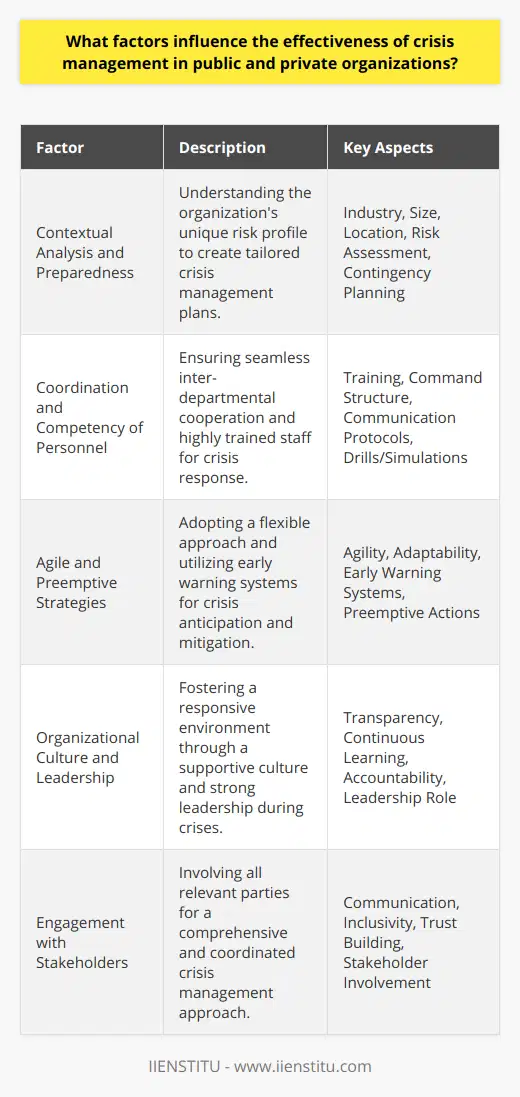
What is an example of crisis management?
Crisis Management in the Tylenol Murders
An iconic example of crisis management is the handling of the Tylenol murders in the early 1980s, by Johnson & Johnson.
Initial Response
When seven people in Chicago died from taking cyanide-laced Tylenol capsules, Johnson & Johnson quickly responded. They promptly recalled all Tylenol capsules, over 31 million bottles, at a cost of over $100 million.
Communication Strategy
The company issued warnings through the media and offered replacements and refunds for returned products. This open communication built a bond of trust with their consumers and the public.
Restoring Brand Reputation
To restore the brand's reputation, Johnson & Johnson reintroduced Tylenol with a new tamper-proof packaging. The company also initiated extensive media campaigns to inform the public of their safety measures.
Next Steps and Takeaway
Johnson & Johnson's handling of the crisis, including its product replacement and media campaign, is seen as a benchmark for similar situations. Its actions help to maintain a strong corporate reputation. Today's companies should consider Johnson & Johnson's approach when creating their own crisis management plans.
Overall, the Johnson & Johnson Tylenol case is an instructive example of crisis management. Its strategic countermeasures effectively controlled the disaster and restored customer confidence, aiding in the brand's recovery.
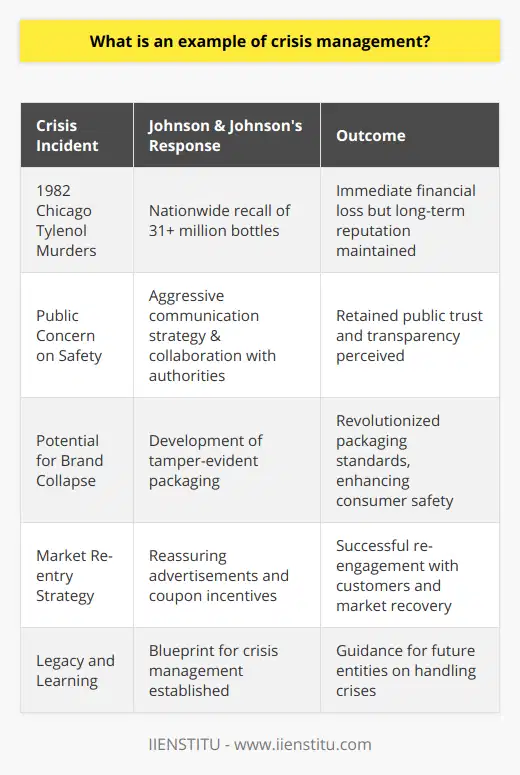
What are examples of crisis situations?
Crisis in Public Health
Public health emergencies, such as infectious disease outbreaks, pose significant challenges globally. Examples include the current COVID-19 pandemic, the Ebola epidemic in 2014, and the H1N1 flu pandemic in 2009.
Natural Disasters
Natural disasters, such as earthquakes, hurricanes, and tsunamis, also represent crisis situations. They cause extensive damage to infrastructure, loss of life and displacement of people. The 2010 Haiti earthquake and 2004 Indian Ocean tsunami are such examples.
Political Crises
Political crises, involving governmental instability, are notable crisis situations. Coups, civil wars, or political unrest, like the Arab Spring movement or ongoing situations in Syria and Yemen, exemplify these crises.
Organizational Crises
Organizations can encounter crises affecting their operations significantly. The Volkswagen emissions scandal and the BP oil spill incident in the Gulf of Mexico illustrate this category.
Personal Crisis
Personal crises can be events dramatically impacting an individual's life. These include tragic occurrences such as personal loss, severe health problems or unexpected job loss.
Financial Crises
Financial crises disrupt economies, often causing significant socioeconomic impact. The 2008 global financial crisis or the Eurozone debt crisis stand as prominent examples.
Technological Crises
Technological failures that lead to substantial loss are further instances. The Fukushima nuclear disaster and the Space Shuttle Challenger explosion serve as examples of these types of crises.
Crisis situations demand attention. Understand them can aid efforts to mitigate their effects. These examples enlighten us about the diverse forms of crises we may encounter.
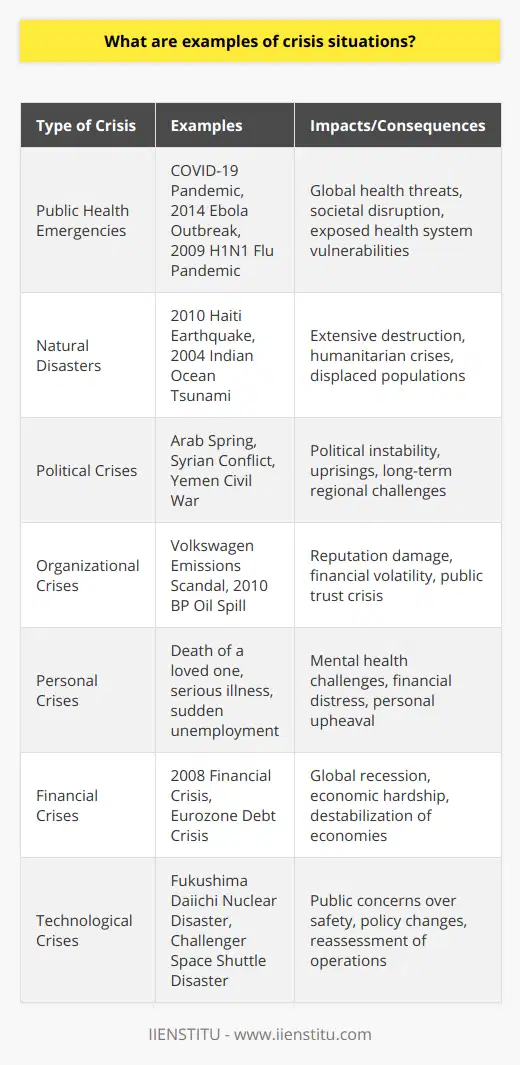
What are the 3 types of crisis management?
Crisis Management Types
Crisis management is a critical aspect of organizational strategy. There are three general types of crisis management: proactive, strategic and reactive.
Proactive Crisis Management
Proactive crisis management involves anticipation and planning for potential crises. Organizations visualize potential challenges and construct response measures ahead of time. This strategy allows for prompt, well-considered actions when a crisis occurs, thereby minimizing adverse effects.
Strategic Crisis Management
Strategic crisis management requires a comprehensive approach. Leaders integrate crisis management into the broader organizational strategy, making it a core element rather than an afterthought. Not only does strategic crisis management plan for crises, it also looks for opportunities to leverage a crisis for organizational advantage.
Reactive Crisis Management
Reactive crisis management, as the name suggests, involves responding to crises after they occur. This requires quick decision-making and immediate action to mitigate damage. Even though organizations cannot predict all crises, reactive management is crucial for unforeseen events.
In conclusion, different situations may require different types of crisis management. A successful organization will skillfully incorporate all three types of crisis management into its strategic planning. By combining proactive, strategic, and reactive approaches, an organization can prepare for, manage, and learn from crises for the benefit of its long-term survival and growth.

What are the essential steps in developing an effective crisis management strategy?
Crisis Identification
The first step in developing an effective crisis management strategy incorporates identifying potential crises. This involves predicting and cataloguing potential threats that could disrupt operations.
Risk Assessment
Following identification, performing a risk assessment allows understanding and prioritization of threats based on their potential impact and probability of occurrence. This step helps in focusing resources where they're needed the most.
Preparation and Planning
Subsequent to the risk assessment, preparation and planning are essential. This includes developing comprehensive crisis management plans involving detailed roles, responsibilities, and protocols to address potential risks. These plans should also include training exercises to better equip staff with crisis-related skills.
Implementation and Crisis Response
The fourth step involves implementing the crisis response upon occurrence of a crisis. This step necessitates decisive actions to mitigate the crisis impact, relying heavily on the prior preparation and planning phase.
Post Crisis Evaluation
Post-crisis, organizations should conduct an evaluation to unearth the effectiveness of the crisis management strategy. This allows identification of areas of strength and those requiring improvement. Consequently, strategies can be tweaked for future crises.
Communication
Lastly, effective communication is key. Organizations must maintain transparent communication with stakeholders including employees, partners, and customers during and post crisis. Clear and regular communication can help manage the crisis more effectively, and restore normalcy quicker.
These steps should not be standalone but rather continuously looped and iterated to effectively manage crises and their potential impacts. The reality is, a well-developed crisis management strategy can be the difference between an organization's continuous success or its ultimate failure.

How do cultural differences impact the approaches to and outcomes of crisis management?
Influence of Cultural Differences on Crisis Management Approaches
Cultural dissimilarities play a significant role in shaping crisis management strategies. Various cultures perceive, react, and handle crises differently which directly impacts the devised mitigation plans. Communication style influences how a culture responds in crisis situations. For instance, high-context cultures prefer indirect communication, implicating a need for subtlety in crisis management. Conversely, low-context cultures prefer direct and straightforward communication, warranting a more explicit approach to crisis management.
Impact on Decision-Making Process
Different cultures have varied decision-making processes which influence their crisis management strategies. Communal societies tend to involve all members in decision-making, which may prolong the response time. In contrast, individualistic societies centralize decision-making power, resulting in quicker but potentially less inclusive crisis handling strategies.
Outcomes of Cultural Programs
Cultural perspectives significantly impact the success and effects of crisis management. A culturally contextual approach to crises can lead to more favorable outcomes. This is due to a deeper understanding and consideration of the cultural norms, behaviors, and ideologies that underpin how societies act during crises. Crisis management that disregards cultural considerations can lead to unintended consequences, such as resistance or misunderstanding of actions taken.
Effect on Resilience
Resilience during crises is culture-dependent. Some societies possess inherent qualities that promote resilience, such as strong community bonds or high adaptability. In these cases, crises often bring about unity and societal growth. However, resilience can be less in cultures where these aspects are lesser or absent, leading to increased vulnerability.
To sum up, there is substantial influence of cultural differences on crisis management approaches and outcomes. Thus, understanding the cultural context is crucial for effective crisis management, enabling societies to tailor strategies that respect cultural norms and optimize positive outcomes.
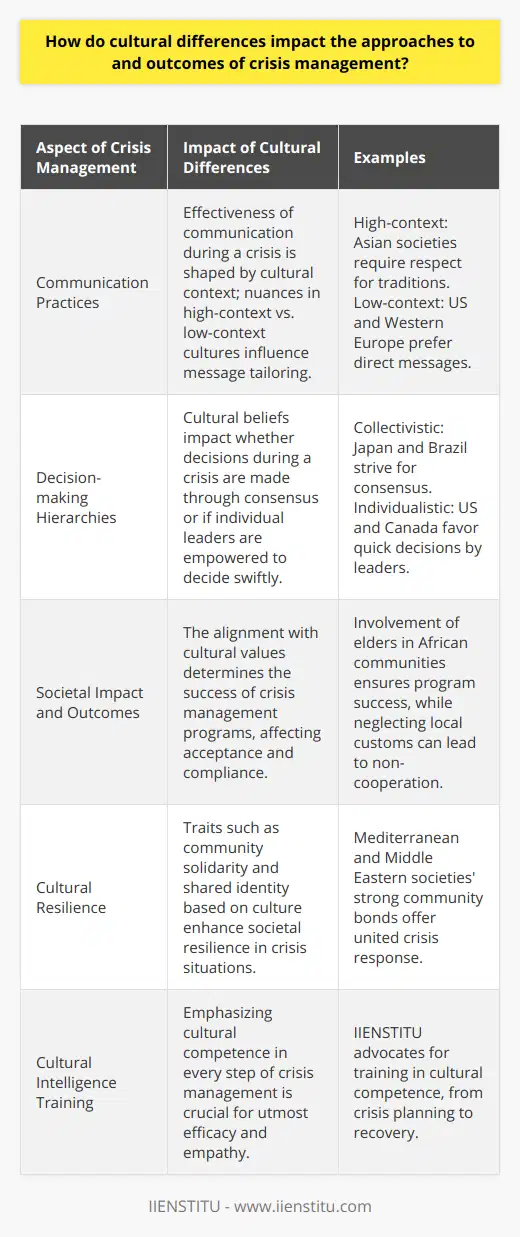
Can you provide examples of effective crisis management techniques from different sectors or industries?
Crisis Management in Healthcare
Often tested in crisis situations, the healthcare sector provides excellent examples of effective crisis management. After the Ebola outbreak in 2014, several hospitals improved their crisis management systems. They incorporated isolation units and trained personnel to handle such cases, reducing mortality and virus spread.
Crisis Management in Aviation
Aviation is another industry well-versed in crisis management. Notable is the Hudson River plane crash in 2009. Despite potential disaster, pilot Chesley Sullenberger landed the plane safely on the water, thus saving all passengers. His intensive training had equipped him with effective crisis management skills.
Crisis Management in the Food Industry
As for the food industry, a striking example would be the Tylenol tampering crisis in 1982. Upon discovering that someone had tampered with their product, causing deaths, Johnson & Johnson promptly removed approximately 31 million bottles from store shelves. It adopted tamper-proof packaging after the crisis, prioritising customer safety over profit.
Crisis Management in Banking
In banking, the 2008 financial crisis forced many institutions to re-evaluate their crisis management protocols. They developed stronger risk management strategies and increased transparency, to instill greater confidence in stakeholders. These reactions demonstrate the importance of proactive and reactive measures in crisis management.
Crisis Management in Tourism
The tourism industry also displays successful crisis management examples. Following the 2002 Bali bombings, the Bali tourism board executed a plan to rebuild trust and increase safety measures. By communicating these changes effectively, they managed to restore confidence and gradually regain tourist numbers.
In summary, effective crisis management strategies differ across industries. Yet, common elements include clear communication, immediate action, proper training, and reassessment of protocols. These contribute to saving lives, maintaining trust, and ensuring business continuity in different sectors.
